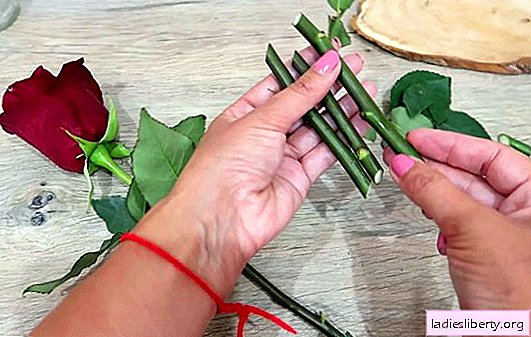
Surely you heard such an omen: "If flowers give from the bottom of my heart, then they stand for a long time." Perhaps it is, or just lucky with the flowers, they turned out to be strong, tenacious and even sprouted while in the vase. Roses are considered to be moody flowers, however, with proper care and simple manipulations, you can grow new flowers from sprouts formed on roses presented in a bouquet. Let's try to preserve the beauty of these wonderful flowers for a long time.
It is necessary to find out why roses grow in a vase with water, are there any ways to provoke this process, and how to plant stems with young shoots.
What roses can sprout in a vase with water
Not every variety of roses sold in bouquets in a store will grow in a vase. Much depends on the conditions of the content of flowers. For example, specimens that have been in a store for long will never sprout. Everyone knows that special preparations are added to the water to prolong the life of flowers. These additives negatively affect root formation. Sellers need fresh, beautiful bouquets in order to sell them, and not propagate and transplant them. It is easy to identify such flowers - the bottom is a little blackened, and the stem begins to wrinkle in a couple of days. It is clear that such a rose will never let roots.
Interesting: roses presented on March 8 are perfect. At this time, the flowers are quickly bought up, they do not stale in stores, drugs are rarely added to them..
Yes, and springtime contributes to active vegetation. This also applies to the summer period - there are more chances to get sprouts.
Let's talk about the varieties of roses and the country in which they were grown. Roots and shoots can appear on a rose of almost any variety, but this does not guarantee that it will take root. This is especially true for roses brought from Holland and other producing countries.
Most foreign varieties are treated with preparations that preserve flowers, so that they fade more slowly and retain a beautiful appearance for longer. The ability to root is reduced, such roses will not take root, even in the presence of young shoots.
Tip: to propagate bouquet roses, take domestic varieties.
It is important to remember that rooting roses that have sprouted in a vase with water is the most unreliable way of propagation. This is due to the fact that such roses, as a rule, are vaccinated with other varieties, for example, bush. This does not guarantee inheritance from the mother plant.
Purchased bouquet roses for the most part have problems with frost resistance.
After cutting, they spend most of their strength on flowering; they are no longer enough to strengthen shoots and roots.
The conclusion can be drawn as follows: you can propagate a rose from a bouquet, however, the process will be time-consuming, and the result is not 100% guaranteed. We try to use domestic flowers that are not processed with drugs.

What kind of roses do not exactly sprout
It is very important to soberly assess the capabilities of the flower. It is necessary to carefully examine the stems for reproduction.
There are several conditions that do not allow the root system and shoots to form:
- the rose has long been cut, and it stands for a long time in a vase;
- the stem is very thin;
- the process of lumbering has begun - the formation of a thick bark and a thickening of the core are visible;
- darkening of the stem in water;
- cracking;
- the peel on the stem is cut off or peeled off.
If you notice at least one of the above, you will have to choose another rose for propagation. And this stem will not grow anything.
How to provoke the sprouting of a bouquet of roses
There are several ways to increase the chances of a rose sprouting. If you try, it will provoke the formation of young shoots and roots.
What is necessary for the germination of roses:
- We put the bouquet in a glass opaque dark container.
- We do not completely change the water, only add as necessary. In the first filling of the container with water, put a tablet of activated carbon.
- We do not use raw water, pathogenic microbes are present in it. For sprouting, melt water or boiled water is ideal.
- There should not be too much water in the vase; pour to an average level. Due to an excess of water, the stem can rot. In addition, air is also needed. Typically, roses give roots at the level of the boundary between water and air.
- The stem of the rose must necessarily have leaves, it is they that produce a substance similar to the biostimulator of root formation. Leaves should not be in water so that the process of decay does not start.
- Place a container with a bouquet of roses in a bright room with a temperature of + 20 ° C to + 24 ° C.
How to determine the germination of the stem of a rose? Callus, a plant tissue that grows on sections, can be seen at the tip of the stem. In fact, this is the result of cell division. If you notice callus, roots will appear soon. In principle, it is already possible to send stems into the ground for rooting.
Note: in order to increase the chances of the emergence of roots, in addition to the foregoing, something else can be done. Add a root stimulation biostimulator to the water. It can be bought at any store. Pour according to the instructions on the packaging.
How to plant and grow a bouquet of roses
So, roses sprouted, our efforts were not in vain. Now you need to plant them, observing a number of conditions that affect the success of the whole venture.
The process can be divided into several stages:
- Preparation of tools.
To transplant a rose from a vase with water into the ground, we need:
- disinfected sharp knife or secateurs;
- pot;
- prepared soil;
- объемом capacity drainage for transplant;
- glass jar or cut bottle / plastic bag.
- The formation of the cuttings from the stem of a rose.
When the flower withers, cut off the bud. Then we make a stalk from the middle of the stem. We select a segment with 3-5 whole buds, the length is 15-20 cm. We cut the stem with a garden knife so that the part with the sprouted shoots completely remains from the bottom, and count the distance from it. Cut the top at a level of 2-3 cm above the topmost kidney.
- Processing the cuttings.
Carefully remove all leaves, leaving only 2-3 pcs on top. Cut them in half. Now for a day we lower the stem in a solution of potassium permanganate to prevent infection.
- Landing in the tank.
We take a flower pot with a drainage hole. On ¼ we fill it with any drainage material. Pour the soil from above and make a recess so that the stalk fits 2-3 of its length. We very carefully straighten the roots, put the stalk at an angle of 45 ° and sprinkle the recess with soil.
- Rooting.
If the soil is warm, the root system will get stronger in a month. Perhaps, shoots will start to grow from the kidneys.
- Care.
Immediately after planting, water the land generously, put the container in a lit place, but without direct sunlight. The temperature in the room should be at least + 25 ° C.
Note: as for the soil. You can buy ready-made in the store and prepare the substrate yourself.
We take 3 parts of sod land, 1 part humus, 1 part of river sand and mix. Soil must be decontaminated with fungicides or by heat treatment - this way we increase the chances that our roses will survive.
After the rose is visibly stronger, it should be looked after as an adult plant.
How to increase the chances of surviving a rose after a transplant
In the list of transplants necessary for transplantation, we indicated a glass jar or a cut bottle, a plastic bag. It is known that roses take root in conditions of high humidity. After the transplant, cover the pot to get the effect of a greenhouse and moisture.
Experienced gardeners do not remove the jar until they see the beginning of rose growth, the appearance of new leaves, the growth of shoots.
When the rose begins to grow actively, you can sometimes remove the jar, gradually increasing the intervals outside the greenhouse conditions. So we will teach our rose to feel comfortable in room conditions with drier air.
From the moment you covered the future rose with a jar, to its absence, it will take about six months.
What difficulties may arise
We are talking about the germination of roses in a vase with water. Such roots differ from those formed in the ground. The root system is thinner, weaker, translucent and very fragile. The slightest fluctuations in moisture upward, and the process of decay begins. When transplanting, the root system can be easily damaged, and it often just breaks down when moving from water to the ground.
Therefore, we must be extremely careful, act very delicately - this is important, otherwise all efforts will go down the drain.
Water contains a large amount of oxygen, so the following phenomenon is often observed: the stem grows a strong root system in a vase, and after a transplant everything perishes, does not take root. There is nothing to be done, everything depends on the strength of the flower itself, from which we sprout roots.
The sprouted stalk can be transplanted both into a pot and immediately into the open ground. However, be prepared for the fact that the rose may not take root - this is a very moody flower.
We hope that you will be able to propagate a bouquet of roses the first time. These flowers will be a wonderful decoration among other indoor or garden plants.











